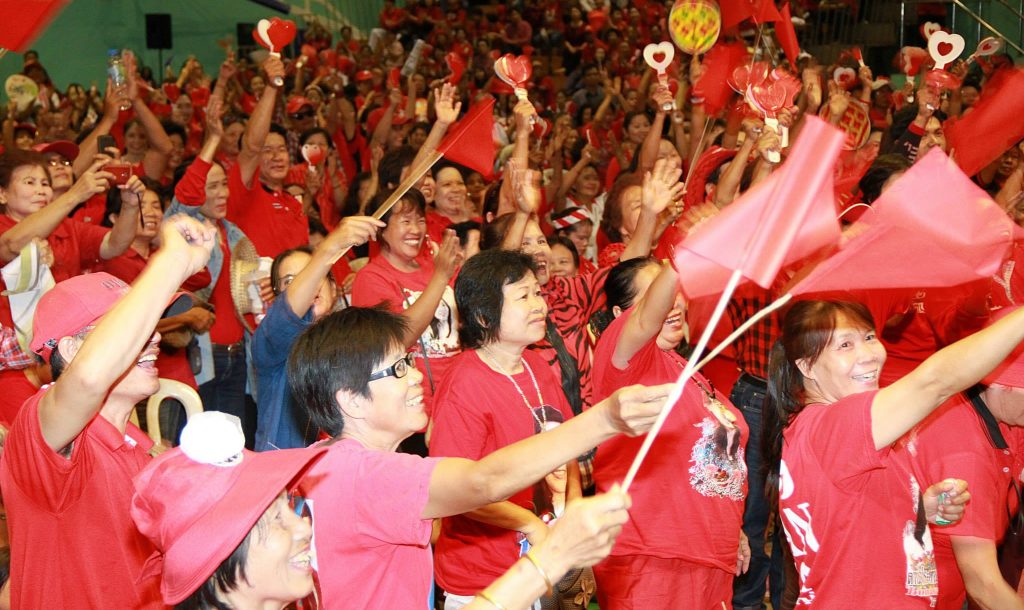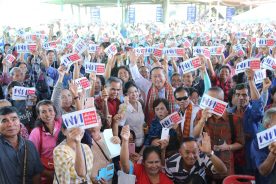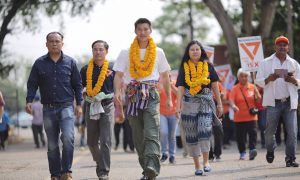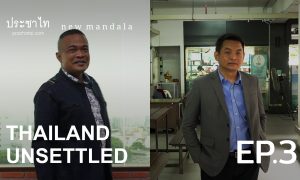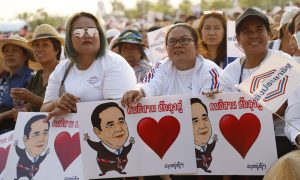It was a sunny monsoon day in October 2017, one year after the promulgation of Thailand’s current constitution. I was sitting on a reed mat on the floor of a simple one-story concrete building with walls on only three sides, in a remote village on the Ubon Ratchathani–Cambodia border. The owner was a woman in her early 60s who had lived here for much of her life. Not knowing when elections would next be held, I nevertheless asked her if elections might finally end the country’s political conflicts. She said firmly and confidently, “No. The rak kaew [taproot] runs too deep”. The woman was a self-proclaimed redshirt—and proudly so. She clarified her point a bit, but I decided not to push further. Certain things are better left unsaid.
Last month came the 24 March 2019 general election—and even worse than my informant’s prediction that the election would not be a solution, it has only created yet another political juncture. The aftermath of Thailand’s much-awaited election remains marred in confusion, secrecy, uncertainty, disappointment and doubt. Questions linger. Why did the Election Commission of Thailand fail to deliver on its promise of reporting nationwide counts by the end of polling day? How did the much-criticised pro-junta Palang Pracharat Party gain enough votes to overtake even the favorite Pheu Thai Party? Will the Commission deal with discrepancies reported during vote tallying throughout the country—and how? Then came a nationwide campaign led by university students to collect signatures for a petition to impeach the 7 core election commissioners for failing to hold a free and fair election. The campaign comes hand in hand with political gatherings to protest the Commission, which remain ongoing at the time of writing.
One positive development to come out of this election, however, is the re-emergence of the tide of democracy. Critics, international and domestic, are raving about the success of Future Forward Party, which in many ways has brought new hope for Thailand’s political future.
Here, however, I turn back to the old force of ordinary people in the northeastern provinces, who have been part and parcel of both electoral and rally politics over the past 10 years. Many of them joined the redshirt mass protests between 2009 and 2010, surviving bloody government crackdowns. Their open mobilisation was suppressed, but they continue to fight on through ballot boxes and in whatever ways they can.
Redshirt identities suppressed, but not forgotten
Since the 2014 coup, the junta has aggressively suppressed the redshirt movement through various measures, ranging from summoning and temporarily detaining leaders to pressing criminal charges with serious offenses. Some redshirts fled the country and have been living in exile. Some ended up serving heavy prison sentences after questionable judicial proceedings. Some were brutally killed. Supporters’ homes have been visited and searched. Pro-democracy academics including myself have been “invited” for “talks” at local military bases—essentially a warning that nobody should disrupt “peace and order”, not even in the name of democracy.
At the height of the suppression, many redshirts tucked their red clothing and accessories away deep in their closets. To some observers, the redshirt movement is defunct. The United Front for Democracy Against Dictatorship (UDD), the core organisation that led the movement at its peak in 2010, has been reduced to just a name. The UDD has not been involved in any political activity since the junta prematurely shut down its referendum watch attempt in 2016.
But being khon suea daeng [redshirt activists] has become an identity for many, especially uncles and aunties who otherwise would be busy trying to get by each day, whether they be farmers, street hawkers, market venders, laborers, or a combination of these. Despite no overt political movements, many redshirts continue to stay tuned to political news and current events, especially through social media, thanks to affordable smartphones with social-networking applications.
The redshirts laid low until mid-December 2018 when the junta decided to partially lift its ban on political gatherings to pave way for future elections. At the time, there was much uncertainty about whether the elections would actually take place, as they had been delayed several times before. In early January 2019, there was speculation (and hope) that they would take place on 24 February. But because there was no clear signal from the elite establishment showing its commitment to the date, activists launched a campaign calling for elections in February.
On 10 January, concurrent gatherings were held in different provinces to support the campaign. In Ubon Ratchathani, a small rally of fewer than 100 people took place on thung si muang [city grounds]. More than half of these activists were familiar faces of mostly older women who had been regulars in redshirt rallies years before. About 10 university students joined the rally alongside them, under the close watch of uniformed and plain-clothes police officers, staff from the provincial governor’s office, and unidentified soldiers. This rally in particular was a microcosm of the final election results: old fighters have been joined by younger, new ones in the struggle against dictatorship.
Between January and mid-March, when political campaign trails were mushrooming here and there in the northeast, redshirts reappeared at large-scale Pheu Thai and Pheu Chart Party campaign rallies, with Pheu Chart’s election campaign led by UDD chairperson Jatuporn Prompan. Pheu Thai averaged around 7000-8000 attendees, which I discussed here and here. A Pheu Chart rally that I observed in Ubon Ratchathani had about 5000 attendees. Redshirts also showed up at a rally of the Next Step towards Democracy group—a remnant of the dissolved Thai Raksa Chart Party—in Roi Et province, despite the dismantling of the party. Only Pheu Chart campaigned heavily around the redshirts’ plight, mostly to point out the illegitimacy of the junta’s rule and how the military had meddled in politics long before the coup.

A man wearing a UDD shirt sitting in the audience of a Pheu Thai rally in Nam Yuen District, Ubon Ratchathani Province on 18 February 2019. Photo credit: Chanathip Boonwit
But how do you identify a redshirt? In all of these rallies, especially the Pheu Thai ones, I spotted attendees donning red shirts with either a UDD logo, graphics or screened texts associated with the redshirt movement. These people braved heavy monitoring by state security forces by visibly wearing their identities, as I have discussed in this article. This is to some degree a small act of defiance—an everyday venting of frustrations despite pressure to abandon or suppress their redshirt roots.
Interestingly, but not surprisingly, I did not see such redshirt clothing, symbols and paraphernalia at a large Future Forward Party rally in Ubon Ratchathani, even though some in the audience had joined the 2010 redshirt protests. If they were still red, they seemed to think that it was not appropriate to make that identity visible, perhaps because Future Forward has never associated itself with previous political movements. Some individual party members, however, are known to have been sympathetic to the redshirt movement.
Pheu Thai defections rejected
So the Redshirts have returned, this time as voters. How did they vote?
Unofficial results show that Pheu Thai won in 7 out of 10 constituencies in Ubon Ratchathani, garnering 36% of votes compared to 52% in the 2011 election. (The 2019 voting results in Ubon Ratchathani are based on figures from a flyer distributed by the Ubon Ratchathani Provincial Election Commission office.)
But this drop in the proportion of votes won by Pheu Thai should not necessarily be interpreted as a waning of support for the party in its stronghold of Isan, as has been hastily suggested by some commentators. This is especially the case once we contextualise grassroots voter behaviour at the level of individual constituencies.
Back in 2011 there were 11 constituencies with much fewer parties competing. This time around, 38 parties fielded candidates in Ubon Ratchathani—an unprecedented number. But in constituencies where established Pheu Thai candidates clearly positioned themselves as allies of the redshirts, such as Somkit Chuakong and Chuwit Pitakpornpanlop, Pheu Thai was victorious.
Somkid, in particular, enjoyed a landslide victory with about a 15,000 vote margin over the same opponent he was pitted against in the 2011 election. His victory is not at all surprising because he has been working closely with his voting base since he became MP. And during the 2016 referendum, voters in his then constituency (southern districts in the province) rejected the draft constitution—the position that most redshirts took in both the 2007 and 2016 constitutional referendums.
What stands out about Somkid’s win is the difference in the margin of victory from 2011, when he beat the same second-place candidate Prajak Saengkham by only 334 points. In 2011, Prajak ran for Chart Pattana Phuea Pandin, but this time he ran for the pro-junta Palang Pracharat Party.
In another constituency, Pheu Thai candidate Chuwit faced a different challenge: gerrymandering, where a large portion of his stronghold was reassigned to another constituency. As a result, he lost a great deal of his voting base and had to campaign for new sources of support in a short period of time. Yet Chuwit managed to secure a victory, though with a close margin of around 3,700 votes.
In Ubon Ratchathani, Palang Pracharat was led by former Pheu Thai party leader Suphon Fong-ngam. Suphon is a seasoned MP who had represented Pheu Thai and its predecessors for a long time. In the 2011 elections, Suphon garnered 66,901 votes—the largest number of votes of all constituencies in the province. The second-place candidate from the Democrat Party lagged far behind with only some 16,000 votes. Suphon beat his opponents hands down.
This time though, Suphon was co-opted to join the newly formed pro-junta party, along with a number of other former Pheu Thai members. Under his leadership, Palang Pracharat geared up for the election with several large-scale campaign rallies boasting at least 7,000-8,000 attendees. Crowds waiving paper flags with the party logo helped the party look good in photographs (at least, the ones that were not doctored), boosting morale in the electoral battle.
Yet in the end, Suphon’s solid past victories and the advantage of being a pro-junta party failed to help at the polls. The best Palang Pracharat did was earn enough votes to place its candidates in the top three in each constituency, but won only 1 out of 10 seats—trailing behind Pheu Thai by over 100,000 votes. Suphon’s brag that he would win all 10 seats in Ubon Ratchathani proved to be hubris. Perhaps he now regrets running as a party-list candidate, and letting his daughter run for the Constituency 3 seat—his own stomping ground his entire political career. She was defeated by a Pheu Thai candidate, also a woman, by 20,000 votes—the largest winning margin of all the Ubon Ratchathani races this election.
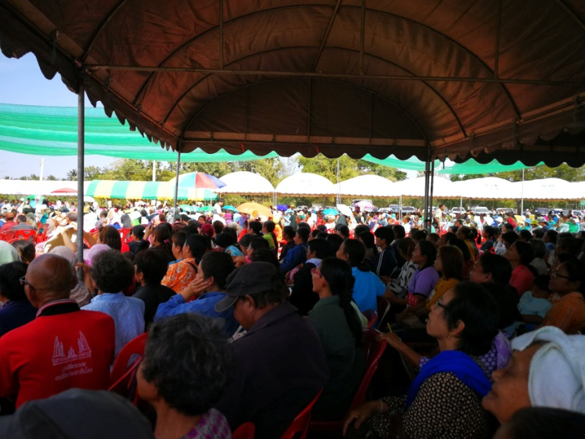
A man wearing a red shirt with the image of the Democracy Monument and the text “khluen khabuan khon rak prachathippatai [Marching of Democracy Lovers] in a Pheu Thai rally in Phon Thong District, Roi Et Province on 13 January 2019. Photo credit: Saowanee T. Alexander
But in making his excuses, Suphon repeatedly took a jab at the redshirts. At one rally, Palang Pracharat had two former redshirt and Pheu Thai-affiliated candidates from neighbouring provinces on stage criticising their own experiences as redshirts. There may be more than one reason that voters abandoned their support for Suphon. But insulting those who still are vested in and affected by deep political schisms, while trying to preach conflict transcendence, did not go down well.
On the evening of 19 March 2019, I was standing in the crowd observing Palang Pracharat’s final rally in Ubon Ratchathani, held on the grounds where the former provincial hall once stood before it was torched in 2010. On stage, Suphon alluded—in Lao, the local language—to the identities of those he believed burned the building down. He did not explicitly name the redshirts, but a woman in the audience stood up and said, “sao wao nae…buea.” [Stop talking. I’m sick of this.] Then she left.
Ubon Ratchathani was not the only province where Palang Pracharat’s verbal attacks on Pheu Thai and the redshirts backfired. In Maha Sarakham, the crowd started booing when a speaker on stage began to attack Thaksin Shinawatra. The crowd, whether or not they were redshirts, was visibly upset. Such displeasure was consistent with the province’s election results, with Pheu Thai winning in all 5 constituencies.
If we look at the rest of the Northeast, Pheu Thai had a constituency victory rate of 82.5% (104 wins/126 contested) in 2011 and 75% (84 wins/112 contested) in the 2019 elections. (The number of Pheu Thai constituency candidates is from here. The number of its wins is from here.)
Pheu Thai won the Facebook Election in Thailand
Online, it was the least active party which proved the most popular during the 2019 Thai election, meaning supporters mobilised with little direction from above.
Interestingly, Pheu Chart did not fare well in Ubon Ratchathani, even though Jatuporn visited the province to give rally speeches that relied considerably on the rhetoric of injustice done to the redshirts. This suggests that the redshirts had more confidence in Pheu Thai than Pheu Chart when the two competed in the same constituencies. Unfortunately, Thai Raksa Chart was dissolved. Otherwise, we would have seen how well Thai Raksa Chart campaign strategist Nattawut Saikuea, another key UDD leader, did at the polls in comparison to Jatuporn (though in provinces other than Ubon Ratchathani, where Thai Raksa Chart did not field candidates). It should be noted, however, that the general public understood that Pheu Thai, Thai Raksa Chart and Pheu Chart were affiliated, despite a rumour that Pheu Chart may not have been as closely connected to the core party, Pheu Thai.
As far as the redshirts are concerned, the nascence of the pro-democracy Future Forward gave more progressive, idealistic redshirts a “bolder” alternative to turn to in the fight to break away from the status quo. Some saw Pheu Thai as too cautious to lead the fight against the establishment—not to mention first-time voters, who may have found Future Forward’s aggressive platform against the junta appealing.
But veteran voters who are more concerned about the grassroots economy, especially those who struggle to make ends meet, still count on Pheu Thai to address their economic problems—something that they believe the party and its antecedents have done well. Pheu Thai has also fought alongside the redshirts. Despite missteps and the inability to break away from the political deadlock, the party stood by the movement through the 2010 ordeal and other political setbacks. Pheu Thai, to many redshirts, has also been under attack. This bond is strong.
It is very likely that most of those still identifying themselves as “red” voted either for Pheu Thai or Future Forward. As the victories of these two parties in the northeast suggest, the pro-democracy force is still strong here. Still, it has been nearly two weeks since the elections, but the Election Commission has not released details of the voting results, while the method used to compute party-list MPs remains mired in dispute. Frustrations have been brewing across the country and voter generations. Criticisms are mounting against the Commission, which has struck back with charges against those criticising it.
The much-anticipated elections are over, but the conflicts certainly ensue. My redshirt informant was right, wasn’t she?
 Facebook
Facebook  Twitter
Twitter  Soundcloud
Soundcloud  Youtube
Youtube  Rss
Rss 